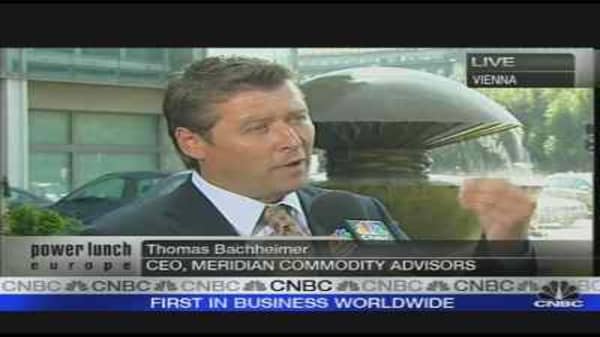OPEC's decision for a modest cut in production isn't likely to stop crude prices from heading lower in the coming months, analysts said.
Even OPEC itself acknowledged that the group's decision early Wednesday to abide by earlier quotas—effectively agreeing to a modest production cut—wouldn't have much impact in the face of slowing global demand.
"My hunch is that prices will be going down despite the decision," OPEC's president Chakib Khelil told reporters. "There is an oversupply—everybody agrees about this."
Some analysts said the modest cut—which may not be observed anyway since the 13 members have a long history of cheating—could allow prices to slide to the $80-a-barrel range, analysts said.
That view was reinforced as oil prices continued to slide toward $100 a barrel despite the OPEC action and a big drop in US crude inventories last week due to Hurricane Gustav.
But any price move significantly below $100 a barrel would probably be temporary, they added, because OPEC expects a rebound in global demand to push prices back up a few months out.
“I think they feel around $100 a barrel is a number they are happy with,” said oil industry analyst Jim Ritterbusch, about Saudi Arabia.
That price still provides producers a nice profit margin—$25 a barrel more than a year ago—but also has the benefit of not further undermining global demand, which has dropped steeply in recent months.
See in video why bearish sentiment hasn't changed in aftermath of OPEC's decision and how low oil will likely go.
Reflecting that decline the International Energy Agency Wednesday offered revised demand growth figures for 2008 and 2009, which were lower than previous estaimtes by 100,000 barrels per day and 140,000 barrels respectively.
The OECD's oil arm still projected global demand growth of 700,000 barrels per day this year over 2007, and an increase of 900,00 bpd over the 2008 figure in 2009.
“They have seen what $140 dollar crude does to global demand—that’s fresh in their memory, Ritterbusch said. "And the last thing they want to do is choke off demand and force alternative fuels and a change of the US car fleet. So they are treading a fine line.”
But that’s hardly the concensus view. “We think they would like to keep prices between the $110-112 range,” said Jason O’Connor, head trader at First National Oil Brokers in Norwalk, Connecticut.
That’s closer to the bullish prediction offered by the US Energy Information Agency.
The EIA’s most recent projection for crude price average in 2008 has dropped $3 per barrel - but that’s just to $119.
Independent oil analyst Tom Kloza says that might be too bullish but is far closer to the mark than the confident predictions of some investment banks of $150-200 by year’s end.
Kloza envisions more violatility. In the short-term prices will continue to slide in the face of weak demand, but that this trend will reverse as demand picks up probably in the winter and more surely in the spring.
So just how far would OPEC allow prices to fall?
“I am sure OPEC would tolerate a brief dip to the $80-$90 price range, recognizing that the winds will be in their favor come winter and [restored demand] in 2009,” says Kloza.
OPEC is pumping 2.18 million barrels a day more than it did a year ago, according to Lehman Brothers, and the modest cut announced late Tuesday is less than one percent of world supply.
O’Connor also thinks OPEC would trim production when prices slip into the mid-$90s and he predicted this would come next spring.
At the same time the cartel contines its constant balancing act of meeting global demand, at prices that do not further weaken an already wobbly world economy, while maximizing revenues.
This juggling act pits price hawks within OPEC, principally Iran, Venezuela, and Libya, who favor output cut-backs to keep prices high, against the more moderate views of Saudi Arabia, joined by Kuwait.
A stronger dollar—which makes revenues go further—have muted the price hawks position somewhat.
Bryon King, an oil industry geologist and industry analyst and editor of Outstanding Investments newsletter, also expects prices to slip into the $90 range in the next couple of months.
“But we better enjoy it while we can,” he adds, because prices will rebound with the economy, especially as oil field depletion rates continue to outpace new supply coming on-line.
Prices could be back to $130-140 as next year's driving season gets underway, he said.
It is unclear just how much Saudi Arabia will be inclined—or have the capacity—to curb prices when they start to rebound with an economic recovery although they recently brought on line a new oil field - Khursaniyah - which has a 500,000 barrel a day capacity.
See in video how OPEC member cheating undermines cartel pricing power.
OPEC accounts for roughly 40 percent of global supply and is currently producing about 32.7 million barrels a day.
Most of the excess is from Saudi Arabia, which in June unilaterally announced it would pump 9.7 million barrels per day in order soften the economic blow of record high prices.
That helped but the precipitous demand drop was a far more significant in reducing prices and some say OPEC has waning influence on oil prices, especially to taming them through production increases.
Some see political calculations in OPEC’s current position.
“They [the Saudis] want American voter to go to the polls in November and vote for the president, Senators and Congressman and everyone else – and not hate oil and not hate oil producers,” said King.
“Oil at $140 would create a political climate in Washington coming out the elections where the number one mission of the next Congress and the next President would to be do something to break the back of OPEC.”
Saudis are unfazed if we are able to manage to get 2-3 percent of our energy needs from alternative sources but a concerted push for real energy independence would be worrisome.
“If we had an election that is all about oil dependency, that would be bad for business for the oil producers of the world.”





